Myron G. Best. Igneous and metamorphic 2003 Blackwell Science
Подождите немного. Документ загружается.

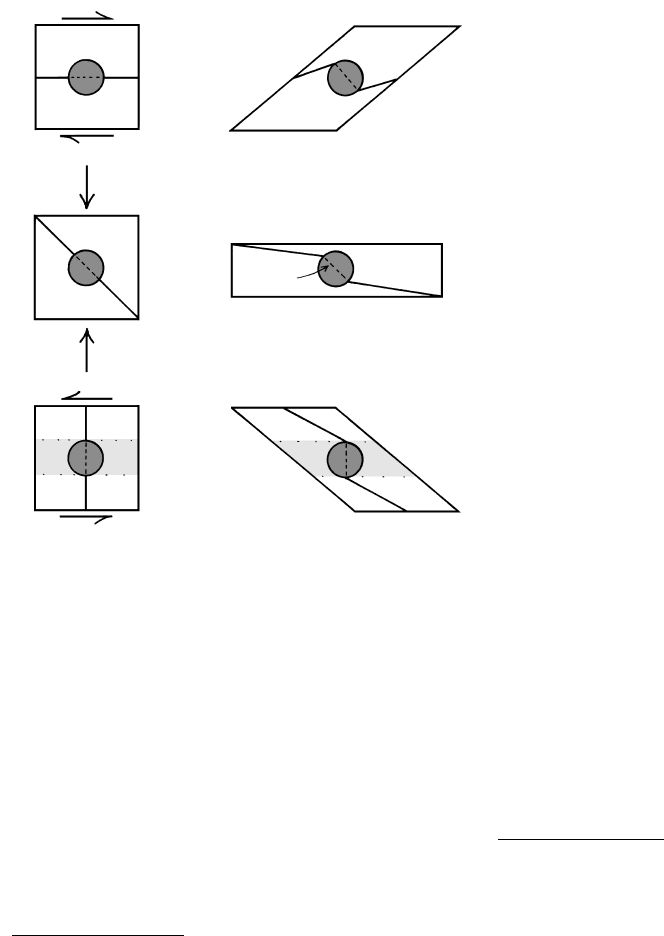
three dimensional geometry of porphyroblast–matrix
relations because the pattern of inclusions can depend
on where the section cuts through the porphyroblast—
in its center or rim—and on its orientation relative to
the surrounding matrix foliation. To overcome incom-
plete and misleading information related to this “cut
effect,” parallel serial slices cut through the rock,
preferrably in three orthogonal orientations, may be
required to elucidate the true three-dimensional fabric
of the internal fabric in the poikiloblast and the exter-
nal fabric in the surrounding matrix. These two fabrics
are sometimes designated as S
i
and S
e
, respectively
(Section 15.1.1).
Prekinematic Fabrics. Mineral grains existing in the
rock prior to deformation are bent, kinked, and exhibit
ribbon texture, deformation lamellae, and undulatory
extinction in thin section under cross-polarized light
(Figures 17.12, 17.14, 17.17, 17.25b). Other prekine-
matic fabrics include fractured grains (Figure 8.7) and
boudins (Figure 15.10).
Prekinematic poikiloblasts hosted in a foliated ma-
trix can have randomly arrayed inclusions or straight
inclusion trails oblique to the matrix foliation. The
former happens where the poikiloblasts overgrew an
isotropic groundmass; one possible scenario is a hornfels
that contains cordierite and andalusite poikiloblasts
(Figure 14.25c) and later develops an overprinting
foliation under nonhydrostatic stress but otherwise
similar metamorphic conditions, while the poikilo-
blasts remain essentially undeformed. Poikiloblasts
with straight S
i
oblique to S
e
might have overgrown an
inherited bedding in a metasedimentary rock and a
subsequent deformation contorted or rotated the
matrix relative to the poikiloblast, or vice versa (Fig-
ure 17.28). Passchier and Trouw (1996, p. 161) recog-
nize an “intertectonic” fabric of the same character in
which a pre-existing foliation imprinted by an early
episode of deformation is overgrown by the poikilo-
blasts and then a later deformation overprints a second
foliation in the matrix while rotating the poikiloblast.
Synkinematic Fabrics. These are perhaps the most com-
monly encountered in rocks formed in an essentially
single-cycle metamorphism where deformation and
mineral growth are simultaneous processes. Many
synkinematic fabrics have no particularly specific fea-
tures indicative of pre- or post-kinematic grain growth
and are simply a texturally equilibrated tectonite fab-
ric, such as in Figures 15.8 and 17.29a. The latter figure
illustrates a common fabric that can be interpreted to
be synkinematic: folia of micas are deflected in the
vicinity of porphyroblasts, bowing over them. Contro-
versy has arisen whether the growing porphyroblasts
exerted a “force of crystallization” that physically
bowed out the adjacent foliation or whether the
wrapped foliation was deformed in the vicinity of the
porphyroblasts, such as by some sort of pressure solu-
tion process. If porphyroblasts grow along grain
boundaries, enveloping unreacted matrix grains (Fig-
ure 17.2), or entirely consuming them, then there can
be little force of crystallization. On the other hand, if
the foliation is deformed by ductile processes at the
more rigid porphyroblasts, in an analogous manner as
Evolution of Imposed Metamorphic Fabrics: Processes and Kinetics
547
(a)
Microlithon
S
i
S
e
(b)
(c)
17.28 Schematic models of development of prekinematic fabric
where a pre-existing poikiloblast (shaded circle) is rotated
relative to the surrounding matrix during homogeneous defor-
mation. The external foliation S
e
in the matrix, which could be
relict bedding in a metasedimentary rock, becomes oblique to
the internal foliation S
i
in the poikiloblast (defined by a trail of
inclusions incorporated from the matrix during growth). Note
the importance of specifying a frame of reference when de-
scribing the rotation of a grain in a rock. Also note that the
deformation paths differ in these three models but the final
relation betwen poikiloblast and its host matrix is similar.
Redrawn from Passchier and Trouw (1996). (a) Model is sub-
jected to right-lateral (dextral) simple shear; the poikiloblast
experiences a clockwise rotation with respect to the matrix.
(b) Model is subjected to coaxial pure shear; poikiloblast
remained stationary but S
e
experienced significant rotation
relative to it and an external frame of reference, such as the
surface of the Earth. (c) Model is subjected to left-lateral
(sinistral) simple shear. S
e
experienced significant rotation
relative to the poikiloblast and to an external frame of refer-
ence, while the poikiloblast remained stationary because it
is embedded within and coupled to a nonrotating, non-
deforming microlithon (shaded; see Section 15.1.1).
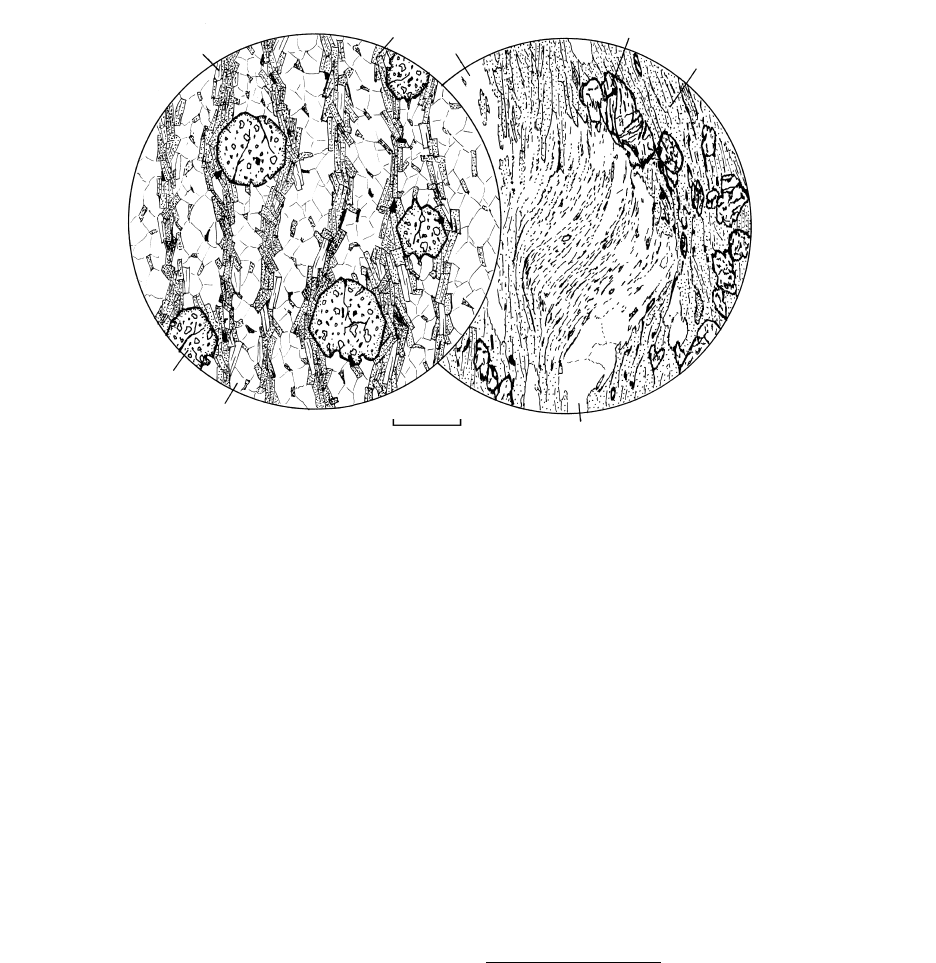
compaction of the viscous glassy matrix around phe-
nocrysts in a welded tuff (Figure 7.34c), then a prekine-
matic timing cannot be excluded.
Mineral aggregates in strain shadows (Figure 15.10b
and Section 15.1.2) extending along the foliation be-
side boudins or porphyroblasts imply growth during
deformation.
A common synkinematic poikiloblast–matrix rela-
tion develops where mineral growth and noncoaxial
ductile flow were essentially concurrent and continu-
ous at similar rates, resulting in a relative rotation
between the growing poikiloblast and the surrounding
matrix foliation. The most common product of this
process is depicted in Figure 17.29b where curved in-
clusion trails that define S
i
in the rotated poikiloblast
are continuous with and merge in the perimeter into
the external matrix S
e
. Deciding which was the actively
rotating fabric element—the poikiloblast or its matrix
—and how to define its rotation with respect to refer-
ence frames has been a subject of considerable debate.
This ambiguity is depicted in Figure 17.28 (although
drawn for a prekinematic fabric the principles are the
same). Garnet porphyroblasts in some schists show
substantial rotation, say, 150°, creating spiral inclu-
sion trails, which most geologists (e.g. Williams and
Jiang, 1999) have interpreted to have formed as the
spherical garnet rotated during growth in a rock sub-
jected to simple shear, hence the designation “snow-
ball” garnet (Figure 17.30). But this traditional view
has been challenged by T. H. Bell, S. E. Johnson, and
548 Igneous and Metamorphic Petrology
Muscovite
Biotite
Albite
(a)
(b)
Epidote
Actinolite chlorite
Garnet
Quartz
0 0.5mm
Albite
17.29 Synkinematic fabrics. (a) Schist in which mica-rich folia bow around porphyroblasts of garnet. (b) Greenschist-facies metabasite. Palona
Schist, San Gabriel Mountains near Los Angeles, California. Thin section from collection of William D. Carlson, University of Texas at
Austin. The albite poikiloblast grew during dextral simple shear that is manifest in the sigmoidal (curved) trails of inclusions (S
i
) and the
inclusion-free albites in the asymmetric strain shadow (see also Figure 17.30c). Rotation of growing poikiloblast was clockwise with
respect to the external matrix foliation, S
e
.
co-workers (e.g. Johnson and Bell, 1996), who argue
that S-shaped inclusion trails result from progressive
growth over crenulated matrix foliation; although the
porphyroblasts may rotate relative to some reference
frame, this is not essential to their formation.
It may be more difficult to accurately interpret
poikiloblast–matrix relations in synkinematic fabrics
that developed where the period of mineral growth
was longer than a brief pulse of deformation at the
beginning or end of the growth (see Figure 17.32b).
Similar difficulties arise where the deformation was the
longer of the two processes.
Postkinematic Fabrics. These are represented in many
cases by modifications of, or grain overgrowths onto,
pre-existing anisotropic fabrics. In Figure 17.31a and
b, depicting postkinematic fabrics, strain-free grains
that lack undulatory extinction under cross-polarized
light have mimicked and partially taken the place of
fabrics produced by deformation, respectively. Figure
17.31c is a crenulated foliation that has been partly
overgrown by a poikiloblastic garnet whose undulating
S
i
faithfully preserves the form of the S
e
. In detail, the
largely reacted phyllosilicate-rich folia might be repre-
sented by trains of small phyllosilicate flakes within the
garnet and the quartz-rich layers by perhaps larger in-
clusions of quartz. There might be a possibility of con-
fusing the internally curved inclusion trails
with a synkinematic fabric but the clearly overprinted
crenulated matrix in Figure 17.31c is in contrast to the
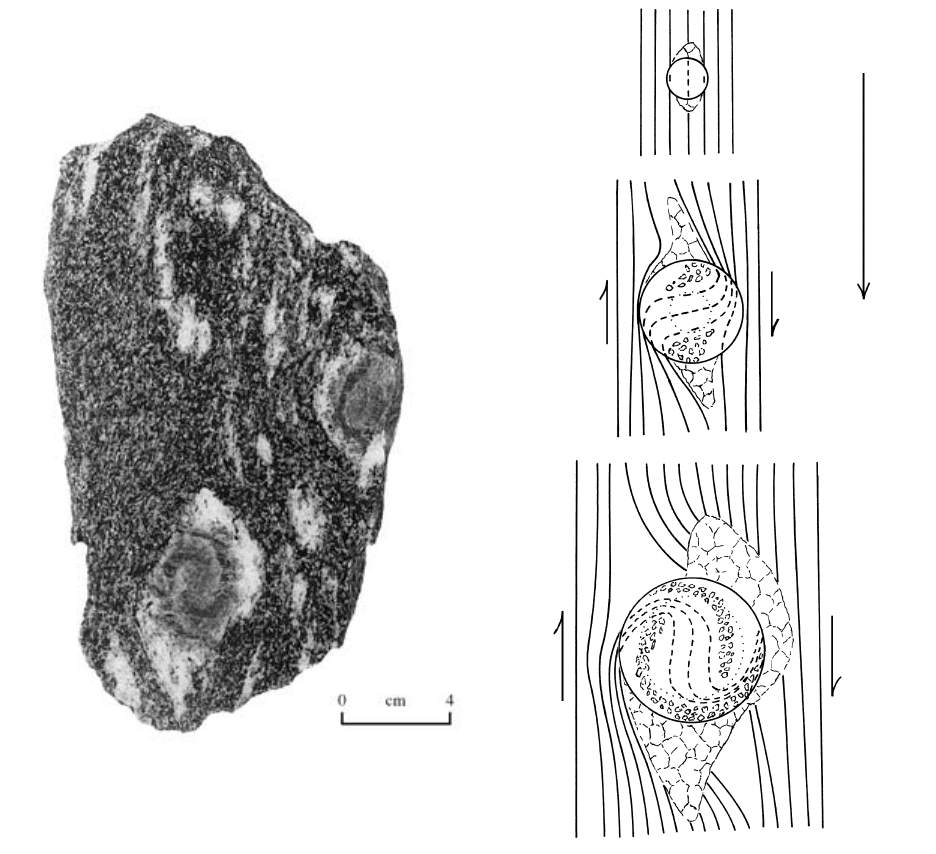
straight S
e
in Figure 17.30. Large biotites in the foliated
chlorite-rich matrix of Figure 17.31d reveal no S
i
that
might provide a hint of an overgrown matrix foliation,
yet their random orientation and undeformed nature is
consistent with postkinematic growth.
17.3.4 Polymetamorphism
The single orogenic cycle presumed in foregoing dis-
cussions is compounded in most long-lived polymeta-
morphic orogens during successive docking of island
arcs and plateaus and locally culminating continent–
continent collisions in the history of plate convergence.
Multiple episodes of deformation, heating–burial and
uplift–cooling take place in many regional tectonite
terranes.
Accurate interpretation of polymetamorphic fabrics
is based on the principles discussed above for the
timing of recrystallization and deformation; however,
the effects of multiple overprinting must be dealt with.
Thus, a particular episode of grain growth might be
postkinematic relative to one foliation-forming event
but prekinematic relative to a subsequent one (Figure
17.32). Once again, poikiloblast–matrix relations can
be of critical importance because poikiloblasts can pre-
serve vestiges of matrix fabrics that have been erased
in the present surrounding matrix by subsequent
Evolution of Imposed Metamorphic Fabrics: Processes and Kinetics
549
Time
(d)
(c)
(b)
75°
180°
0°
17.30 Synkinematic “snowball” garnet poikiloblast in weakly foliated plagioclase–biotite–quartz gneiss. (a) Sample from near the ductile shear
zone that separates the Proterozoic Grenville and Archean Superior Provinces, near Sudbury, Ontario (see Figure 19.31). The spiral tex-
ture within the poikiloblast in lower center is expressed by a train of felsic inclusions incorporated from the asymmetric strain-shadow
zone into the growing garnet while it was being rolled, like a snowball, as shown schematically in (b)–(d) after the model of Schoneveld
(1977). Angles denote amount of rotation between S
i
and S
e
.
(a)

overprinting mineral reactions and/or deformation
(Special Interest Box 17.2 and Figure 17.34). In this
respect, poikiloblasts are like photographs of past
events that can be viewed at later times.
Three guidelines in dealing with polymetamorphic
fabrics can be kept in mind:
1. Apparent overprinting in a rock fabric may be the
result of only one continuous episode of deforma-
tion. Transposition of a pre-existing foliation forms
a new foliation that subsequently may be folded
and itself become transposed during continuation
of the same simple shearing process (Figure 17.33).
This happens in some ductile shear zones.
2. The converse of 1 also happens, namely, a second
episode of deformation merely enhances the effects
of a first without producing a distinct overprint. A
rock that possesses a flattening foliation created by
pure shear and expressed by parallelism of mica
flakes might be subjected to a distinct later episode
of deformation of the same style and orientation
550 Igneous and Metamorphic Petrology
(a) (b)
(d)
(c)
17.31 Postkinematic fabrics produced by recrystallization following after deformation, as seen in thin section. (a) Individual flakes in the
folia of micas defining the fold are not bent or otherwise strained because each has a uniform optical extinction under cross-polarized
light. They can be interpreted to have mimicked a previously folded layer. (b) Strained plagioclase that shows bent twin lamellae and
undulatory extinction under cross-polarized light has been partially replaced by small, lower energy, strain-free polygonal grains. At least
two interpretations are possible. First, the texture is postkinematic and was produced by static annealing after stress-induced deforma-
tion. Second, the small grains may be a product of dynamic recrystallization during dislocation creep (compare Figures 17.26 and 15.15).
(c) Garnet poikiloblast contains wavy trains of inclusions in continuity with the crenulated folia in the matrix. This is consistent with a
postkinematic relation because, in addition to the continuity between S
i
and S
e
, the inclusion trains mimic the amplitude and wavelength
of the crenulated matrix and other poikiloblasts show a similar relationship. They are not likely to be synkinematically rotated garnets as
in Figure 17.30. (d) Oriented chlorite flakes are transected by randomly oriented biotites that are interpreted to have formed during a
late episode of recrystallization in a hydrostatic stress field.
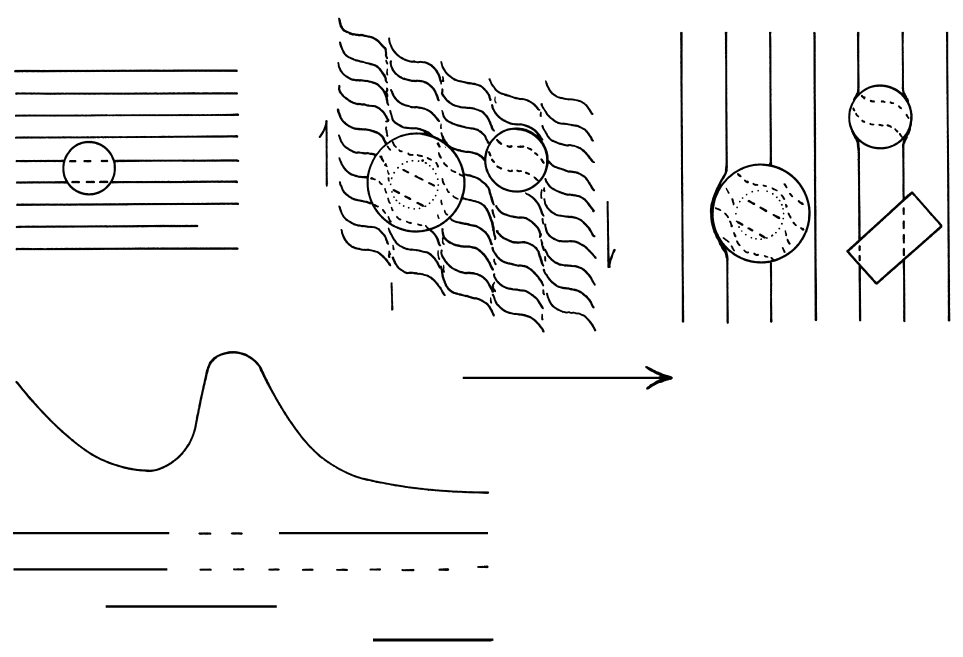
under similar metamorphic conditions that only
strengthens the expression of the original foliation.
3. Multiple episodes of deformation can be diachro-
nous—occurring at different times in different
places within the orogen. One way this happens is
during oblique convergence of an oceanic plateau
as it rams at different times along strike against the
overriding continental margin. This diachronism
can present challenges in correlating deformation
and recrystallization events throughout a large oro-
gen, especially where it might have been dismem-
bered and parts displaced large distances during
later faulting.
17.3.5 Shear-Sense Indicators
All three components of deformation—translation,
rotation, and distortion—can be manifest in tectonites,
such as in mylonitic rocks formed in ductile shear
zones in the deep crust where there has been differen-
tial movement between adjacent rock masses. (Deep-
crustal, ductile shear zones are the counterpart of
brittle faults in the shallow cooler crust, as shown in
Figure 8.9.) The translation component is revealed in
offset markers, while distortion, or strain, is manifest
by changes in shape of various markers, such as cob-
bles and lava pillows in metamorphosed conglomerate
(Figure 14.13) and subaqueous lava flows (Figure
14.20), respectively. A rotational component can be
seen in the fabric in Figure 17.30. Additional rotational
fabric elements that serve as kinematic indicators of the
sense of shear are depicted in Figure 17.35 (see also
Barker, 1990, pp. 89–103; Passchier and Trouw, 1996,
pp. 109–29; Snoke et al., 1998, pp. 305–67). In Figure
17.35, the direction of shear can be imprinted on shear
planes as some sort of parallel lines, which may be a
stretching lineation (Section 15.1.1) or aligned elongate
mineral grains. However, this lineation gives no actual
indication of the sense of shear, or which of the two
Evolution of Imposed Metamorphic Fabrics: Processes and Kinetics
551
(c)(b)(a)
(d)
D
S
1
S
2
S
1
S
2
Time
S
2
S
1
Phyllosilicates
Garnet
Quartz
Staurolite
17.32 Schematic poikiloblastic growth and deformation that preserves stages of foliation development during polymetamorphism. (a) Garnet
poikiloblast (shown as a circle for simplicity) encompasses inclusions aligned parallel to foliation S
1
. (b) Deformation of S
1
and creation
of a new crenulation foliation S
2
. Continued growth of garnet poikiloblast, incorporating into its rim curved trains of inclusions from
crenulated foliation. Note core that preserves relics of undeformed but now rotated S
1
. A new garnet nucleates and as it grows also
incorporates curved trains of inclusions from crenulated foliation. (c) S
1
is completely obliterated by creation of the new foliation S
2
except for preserved relicts in garnet poikiloblasts. Rectangular staurolite poikiloblast grows, incorporating inclusions mimicking S
2
but
not earlier S
1
that had been destroyed in the matrix. Redrawn from Johnson (1999). (d) Chronologic relations between mineral growth,
deformation, D, and development of foliations S
1
and S
2
.

552 Igneous and Metamorphic Petrology
Special Interest Box 17.2 Unraveling episodic
poikiloblast growth and folding: a case history
An example of how poikiloblast–matrix relations can
be used to determine the complex history of a poly-
metamorphic terrane is provided by a study of the
Fleur de Lys Supergroup, northern Newfoundland
(Stallard, 1998). This upper-greenschist to lower-
amphibolite facies terrane is believed to represent a
late Proterozoic–early Ordovician continental margin
developed on Grenville basement rocks (Section
19.5.1) overriden by thrust sheets during the Taconic
Orogeny. In outcrop, the dominant fabric is a folia-
tion, designated S
5
, expressed by compositional layer-
ing and parallel preferred orientation of mica flakes;
it is parallel to axial planes of tight to isoclinal folds
and has been overprinted by later crenulation folia-
tions, S
6
and S
7
, and associated folds. The matrix
surrounding the garnet poikiloblasts is composed
of quartz, muscovite, biotite, ilmenite, garnet, albite,
epidote, chlorite, carbonate, and graphite; their
growth obliterated foliations earlier than S
5
.
Examination of numerous oriented thin sections
reveals a complex history of episodic poikiloblast
growth incorporating a succession of multiple crenu-
(a) (b)
(d)
(c)
Time
S
1
S
2
S
2
S
3
17.33 Schematic development of overprinting transposition folia-
tions and asymmetric folds by progressive simple shear. (a)
Body that contains a foliation S
1
is subjected to simple shear.
(b) Asymmetric folding and development of an incipient
axial plane foliation S
2
. (c) S
1
is transposed (Figure 14.19)
along S
2
shear surfaces; note relict fold hinges from (b).
(d) Further simple shear creates asymmetric folds in S
2
and
parallel remnants of S
1
; a new incipient axial plane folia-
tion S
3
appears. Only a few relict fold hinges from (b) are still
evident.
lation folds of evolving foliations (Figure 17.34).
Curved inclusion trails in poikiloblasts do not appear
to have resulted from rotation during syntectonic
growth. Foliations evolved by growth of matrix grains
punctuated by episodes of crenulation folding and
transposition. Four distinct growth phases of garnet
poikiloblasts, G
1
–G
4
, are recognized, but not in every
poikiloblast. In contrast, albite poikiloblasts grew
during only one late episode. Evidence for each
growth phase and their timing is based on inclusion
trail mineralogy, texture, geometry, and poikiloblast–
matrix relations. In garnet poikiloblasts, inclusion
trails of S
4
and S
5
have counterparts in the surround-
ing matrix but trails of S
1
, S
2
, and S
3
do not.
Each phase of garnet poikiloblast growth seems to
have begun early in a spurt of foliation development
and resulted in overgrowth on earlier foliation(s)
adjacent to the poikiloblast. As growth was arrested,
the foliation was subsequently intensified against the
rigid garnets, which grew mostly within quartz-rich
domains in the rock rather than across high-strain,
mica-rich domains of the actively developing folia-
tion. The micaceous folia might have functioned as
some sort of barrier for access of nutrient ions for
garnet growth.
possible motions produced the lineation. If the overly-
ing rock moved to the right relative to the underlying
rock in Figure 17.35 the sense of shear is right-lateral,
or dextral. If to the left, sinistral. To accurately deter-
mine the sense of shear we must examine a surface of
the tectonite that is oriented perpendicular to the shear
plane, which might be a foliation, and parallel to the
lineation (the direction of shear). In the absence of a
natural so-oriented examination surface, such as a
joint, it is necessary to collect an oriented hand sample
from the outcrop and then cut an examination surface
with a diamond saw. In any case, preparation of several
differently oriented surfaces, and usually thin sections,
may be necessary to verify the true kinematic pattern.
For example, Figure 17.35 shows that on some oblique
surfaces an offset marker gives the opposite, and,
therefore, false, sense of shear. Thus, an observation
made on a single oblique section can be misleading.
Determination of the direction and sense of shear
accompanying differential movement of rock masses,
often from microscopic textural features in tectonites,
can be of fundamental relevance in understanding the
tectonic evolution of metamorphic terranes and the evolu-
tion of continental-scale orogens where they develop.
This is yet another example of a recurring principle in
petrology, namely, attention to the smallest of details
can provide significant information regarding large-scale
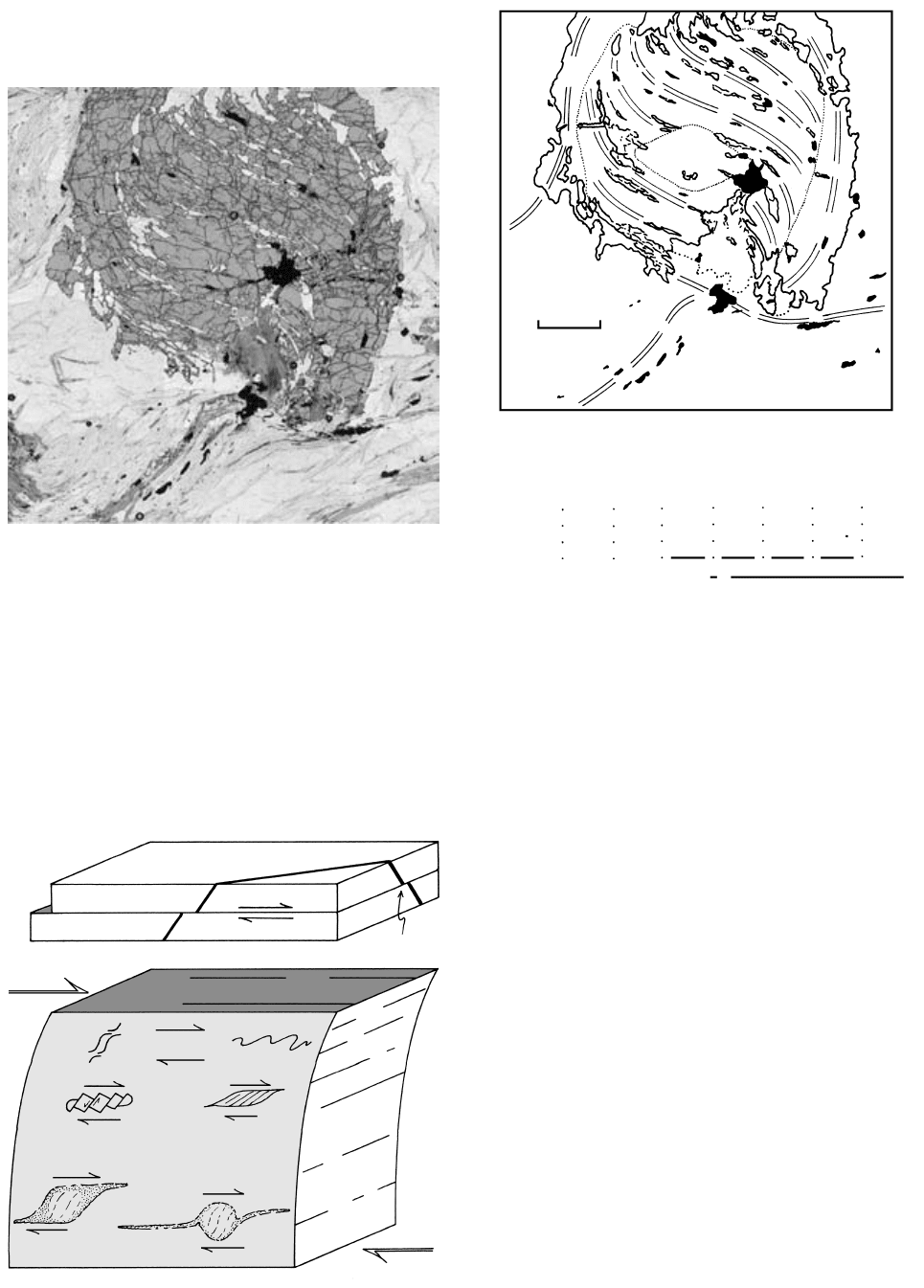
(a)
(c)
Crenulation
foliation
development
Poikiloblast
growth
Garnet
Albite
S
1
S
2
S
3
S
4
S
5
S
6
S
7
S
4
S
4
S
5
S
4
G
3
S
3
G
1
G
2
S
3
G
3
G
3
S
3
S
4
C
0mm1
(b)
17.34 Complex inclusion trails and chemical zoning in a poikiloblast from the Fleur de Lys Supergroup, Newfoundland record episodic growth
and deformation. (a) Photomicrograph under plane-polarized light. (b) Annotated drawing showing successive foliations (thin double
lines) and growth zones G
1
(contains 6–8 wt.% MnO), G
2
(2–6 MnO) that constitutes the bulk of the grain, and G
3
(2 MnO) as fringes
on left and right. Subtle sparse quartz and rutile inclusion trails (oriented up and down figure, not obvious) in growth zone G
1
may
represent relict foliation S
2
. Quartzose strain shadow around relict grain G
1
was crenulated and overgrown during G
2
, preserving relict
S
3
as curved inclusion trails of quartz. S
3
inside poikiloblast is continuous with S
4
in upper left and truncated by S
4
in lower right. S
4
and
S
5
are evident in matrix. Black grains are Fe–Ti oxides. C, retrograde chlorite replacing garnet. Photomicrograph and data courtesy
of Aaron Stallard. Reproduced with permission from Stallard A. 1998. Episodic porphyroblast growth in the Fluer de Lys Supergroup,
Newfoundland: Timing relative to the sequential development of multiple crenulation cleavages. J. Metam. Geol. 16: 711–728. Copyright ©
1998 by Blackwell Science.
(a)
True dextral
sense of shear
Apparent
sinistral offset
Shear direction
Shear
plane
(b)
(c)
(e)(d)
(g)
(h)
(f) S–C
fabric
17.35 Schematic shear-sense indicators and related features in non-
coaxial simple shear deformation. These kinematic indicators,
shown here for a dextral sense of shear, are most accurately
determined on an examination surface (light shaded) oriented
perpendicular to the shear planes (dark shaded), or tectonite
foliation, and parallel to the shear direction, manifest by pen-
etrative lineations. (a) Offset planar marker, such as a dike or
vein, that is oblique to the shear surfaces. Note that an oppo-
site, false sense of offset is apparent in a improperly oriented
examination surface. (b) Asymmetric crenulation cleavage
(Section 15.1.1 and Figure 15.3; see also Passchier and Trouw,
1996, p. 112 for distinguishing between cleavages formed
by coaxial versus noncoaxial shear). (c) Asymmetric folds.
(d) Fragmented porphyroclast that is stepped by an antithetic
(sinistral) sense of shear. (e) Lenticular mica “fish” showing
inclined (001) cleavage. (f) S–C fabric shown in Figure 17.36a.
(g) and (h) Mantled porphyroclasts typical of mylonites and
commonly of feldspar in quartzo-feldspathic protoliths. The
mantle surrounding the intact but highly strained porphyro-
clast is composed of a fine-grained aggregate of the same phase
that was sheared off during ductile flow of the surrounding
matrix and concentrated into the strain shadows on each side
of the porphyroclast. But because of its rotation in the non-
coaxially flowing matrix, the mantle was drawn out along the
shear surface, forming asymmetric tails that are like either of
the Greek letters sigma () or delta ().
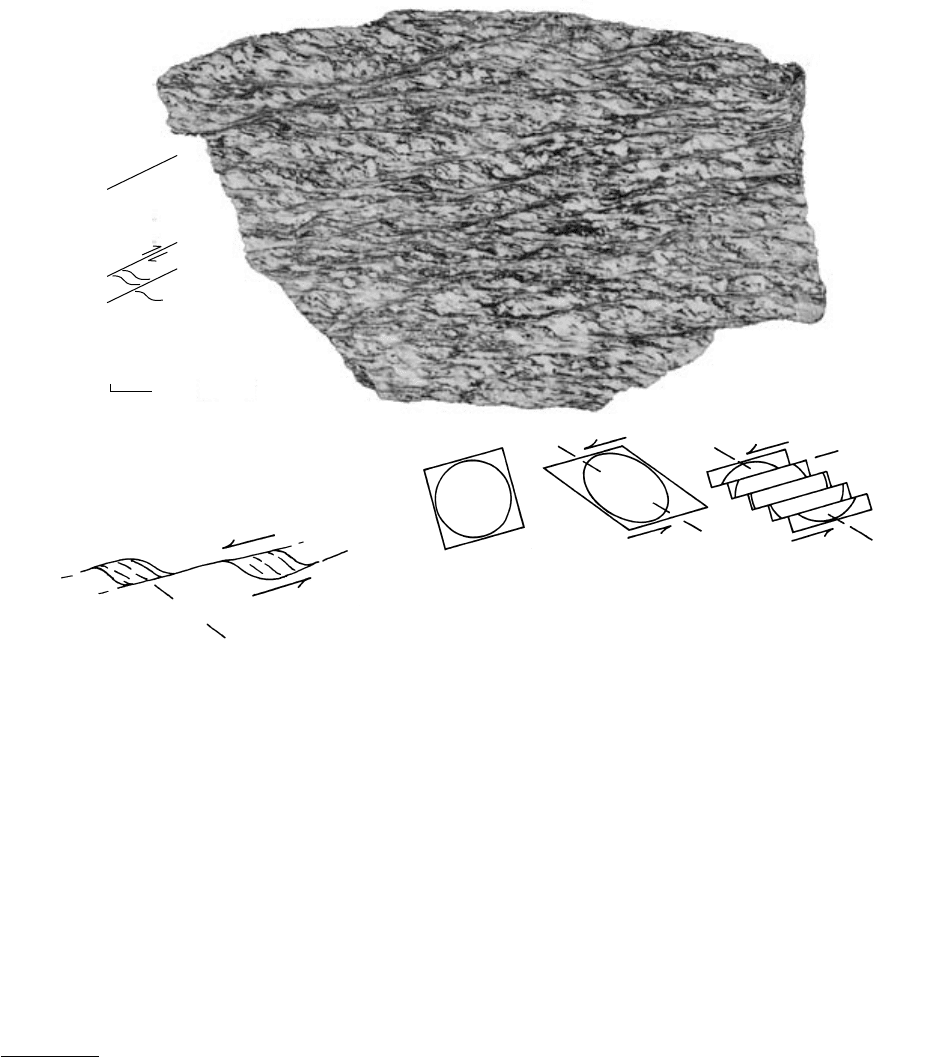
(a)
02cm
C
S
17.36 S–C fabric consisting of two simultaneously developed foliations serves as a indicator of sense of shear during noncoaxial deformation in
a ductile shear zone. (a) Polished slab of Santa Rosa mylonite, Palm Canyon, California, in a late Cretaceous–early Tertiary thrust zone
affecting granitoids of the Southern California Batholith. Mylonitization occurred at about 500°C and was created by a “general” shear
that consisted of a simple shear plus a component of pure shear normal to the compund foliation. Photograph provided by Carol Simp-
son. Reproduced from Simpson C. 1986. Determination of movement sense in mylonites. J. Geol. Ed., 34: 246–252, with the permission of
the National Association of Geology Teachers. (b) “Mica fish” in S–C fabric. The (001) basal cleavage defines S. (c) Possible explanation
of development of S–C fabric according to Takagi (1992).
geologic features. It can be of crucial importance to
decide, for example, whether a particular shear zone
resulted from convergent-thrust or divergent-extensional
motion between adjacent terranes, or whether the
motion was not dip slip but strike slip, and if so
whether it was right- or left-lateral, or oblique-slip?
S C Fabric. Compound foliations are another im-
portant kinematic fabric element, in addition to those
depicted schematically in Figure 17.35, that indicate
sense of shear. They develop simultaneously in shear
zones and are especially evident in quartzo-feldspathic
protoliths (Figure 17.36a). The two foliations, first
described by Berthé et al. (1979), are designated as S-
surfaces (from the French schistosité for the plane of
flattening; compare German Schiefer for schist) and C-
surfaces (French cisaillement for the plane of shearing).
S is defined by aligned mica flakes, ribbonlike quartz,
and feldspar aggregates. The oblique (45°) C-surfaces
are parallel to the overall shear zone and consist of
spaced, thin, discrete zones made of finer, more highly
strained grains. The sigmoidal form of S between C-
surfaces as well as the aligned mica flakes (“mica fish”
in Figure 17.36b, c) along S indicate the sense of sim-
ple shear on them. A stretching lineation is common on
the C-foliation. Although S–C fabric resembles crenu-
lation foliation found in low-grade phyllosilicate-rich
rocks (Figures 14.18 and 15.3; Section 15.1.1) and
transposition foliation (Figure 14.19), these two folia-
tions are superposed on distinctly earlier surfaces of
anisotropy, whereas the two foliations in S–C fabric
develop simultaneously.
17.3.6 Patterns of Deformation and Flow:
Tectonic Significance of Fabric Geometry
Interpretations of the tectonic significance of anisotropic
fabrics are a concern of the structural geologist (e.g.
Twiss and Moores, 1992), yet this cannot be ignored by
petrologists seeking some understanding of the evolu-
tion of metamorphic terranes. One basic question that
554 Igneous and Metamorphic Petrology
(b)
Mica fish
(001)
(c)
S
S
C
Initial
undeformed
state
Distributed
continuous simple
shear; S-surface
parallel to plane
of flattening
Simple shear along
spaced discrete
C-surfaces; composite
S–C fabric

might be posed is how the orientation of the L- and
S-fabric elements—the lineation and foliation in the
tectonite—relate to the principal axes of stress in the
nonhydrostatic stress field that caused the deformation
(Section 8.1). Accurate and complete evaluation of all
three components of deformation is generally im-
possible in real rocks because of the lack of suitable
markers. Furthermore, the observed fabric of a rock
reflects a complex strain history, or deformation path,
that is the sum of all the increments of deformation it
has experienced throughout its entire history, from the
initial to the final state (Box 17.1). If the initial fabric
of the undeformed rock was perfectly homogeneous and
isotropic and the deformation was perfectly coaxial,
then the resulting strain can be homogeneous. But real
rock bodies are almost never isotropic and they are
certainly not homogeneous on most scales; all sorts of
linear and planar discontinuities are mechanically and
rheologically significant in stressed rock. Furthermore,
strictly coaxial deformation is generally deemed to be
uncommon in metamorphic rock systems. Thus, it is a
long interpretive jump from the observed pattern of
the fabric to the state of stress, little of which can be
inferred unambiguously. Principal axes of stress do
not necessarily coincide with the axes of strain ellip-
soids in deformed rocks.
In many instances, the dominant foliation in a meta-
morphic rock is parallel to the plane of flattening in the
ellipsoid (Figures 14.12 and 17.37). Simple flattening
yields only a foliation, as in S-tectonites, and simple
extension (constrictional strain) yields only a lineation,
as in rare L-tectonites. At least two possibilities exist
for widespread L–S tectonites. Foliated and lineated
fabrics that have no evidence for rotational movement,
or have shear-sense indicators in opposite directions,
were possibly produced by pure shear. If, on the other
hand, the L–S tectonite shows a consistent sense of
shear (Figure 17.35), then deformation by simple shear
is likely. In this pattern of ductile flow, the symmetry of
the overall fabric is monoclinic, with the single sym-
metry plane perpendicular to the foliation and to the
axis of rotated crystals and/or parallel to a stretching
lineation, in contrast to the orthorhombic symmetry of
the pure shear fabric.
Only in cases of extreme strain do shear planes
approach parallelism with the plane of flattening in the
strain ellipsoid (Figure 17.37). Foliations are not always
planes of shear, one exception being the C-plane in C–S
fabrics (Figure 17.36).
17.4 ORIGIN OF ANISOTROPIC FABRIC
IN METAMORPHIC TECTONITES
The problematic origin of anisotropic tectonite fabric
has intrigued geologists since the infancy of the science
of geology. The problem is not only petrological but
structural as well because, for example, foliation is
commonly parallel to the axial plane of associated folds
and lineation parallel to hinge lines.
Field and laboratory investigations have shown that
imposed anisotropic fabrics in tectonites result from
penetrative ductile flow in nonhydrostatic stress fields.
Variations in the details of tectonite fabrics imply a
variety of factors affecting their origin, including the
character of the applied nonhydrostatic stress, the
magnitude of the overall strain, the rate of strain, T,
the inherited fabric of the body (whether anisotropic
or isotropic), its grain size, and mineral and chemical
composition, especially the availability of water or
other fluids. Moreover, imposed fabrics can be inho-
mogeneous on different scales, probably reflecting
inhomogeneities in one or more of these factors.
Tectonite fabrics can have any one or more of the
following properties:
1. A preferred dimensional orientation of typically in-
equant mineral grains, such as oriented amphiboles
(Figure 15.8) and oriented mica flakes (Figure
17.29a), as well as flattened and elongate grains of
minerals that are typically equant, such as quartz
and feldspar (Figures 17.14 and 15.17).
2. A preferred orientation of crystallographic axes
and planes, that is, the crystal lattice. In typically
inequant mineral grains, such as amphiboles and
phyllosilicates, a shape orientation as in property 1
automatically, in most cases, ensures a lattice orien-
tation. However, typically equant minerals low in
the crystalloblastic series such as quartz, carbon-
ates, and feldspars can possess strong lattice pre-
ferred orientation without shape orientation, and
vice versa.
3. A compositional layering, expressed usually by
planar variations in concentration of felsic and mafic
minerals (Figure 15.2, see also Figure 19.24a) or of
felsic and phyllosilicate minerals (Figure 15.3).
Current thinking regarding the origin of these three
types of anisotropy is discussed next.
Evolution of Imposed Metamorphic Fabrics: Processes and Kinetics
555
17.37 Progressive deformation by simple shear on surfaces parallel
to the plane of flattening of an initial (large) finite strain ellipse.
The plane of flattening, represented by the maximum axis of
the ellipse, rotates away from the shear surfaces but toward the
plane of flattening of the smaller reference ellipse that shows
the progress of strain in the experiment. Redrawn from Twiss
and Moores (1992).

17.4.1 Preferred Dimensional Orientation of
Mineral Grains
There are four mechanisms that produce shape
anisotropy in grain aggregates, depending on the
mineralogical composition of the rock and the meta-
morphic conditions.
1. Bodily rotation of inequant grains. Relatively rigid
inequant grains can rotate in a more ductile matrix
toward the plane of flattening by either pure (Fig-
ure 17.38) or simple shear. The grains do not
necessarily change shape during rotation. Ductility
in the matrix can be a consequence of constant-
volume plastic deformation of weaker grains or
volume-reducing pressure solution of more soluble
minerals. Very large strains are necessary to pro-
duce strong preferred orientations solely by rota-
tion if the inequant grains were initially random.
Grains unfavorably oriented with respect to the
strain pattern do not rotate.
2. Intracrystalline plasticity. Plastic slip and twinning
are verifiable mechanisms of producing changes in
grain shape and preferred orientation of grain
shapes in aggregates where none existed prior to
deformation. Several hundred percent extension is
possible in simple shear by slip in a confined grain
(Figure 17.15) but the strain is more limited in
twinning and kinking. Not only does the external
form of the grain change shape, preferred orienta-
tion of grain lattices also develops by internal rota-
tion of crystallographic planes and axes (discussed
later). Development of preferred orientation in a
grain aggregate is modeled in Figure 17.19.
3. Differential pressure solution and precipitation.
In the presence of an intergranular fluid, mineral
grains can be dissolved in highly stressed parts and
the solute precipitated elsewhere, either on the
same grains in strain shadows or at some distant
site, such as in veins. Neighboring relatively less
soluble grains that are inequant may be bodily
rotated as the matrix around them collapses during
volume loss. In crenulation foliation and other
types of spaced cleavages, differential solution
transfer may remove silica from the limbs of the
crenulations, leaving higher concentrations of less
soluble minerals that become aligned in the newly
imposed foliation (Figure 15.3). It is expected that
this sort of solution activity would occur in fine-
grained rocks, such as slates and phyllites where
diffusion paths are short. Nonetheless, crenula-
tions and apparent associated differential solution
is evident in some coarser grained, higher grade
schists.
4. Recrystallization. During recrystallization, grains
advantageously oriented in the prevailing nonhy-
drostatic stress field may grow, whereas others less
favorably oriented may be selectively eliminated. In
this competitive growth system, elongate mineral
grains tend to grow their longest dimension in the
direction of least work against the least compressive
stress,
3
, and their shortest dimension in the
1
direction. In mimetic recrystallization, new grains
nucleate and grow on former, perhaps smaller, ori-
ented grains of similar atomic structure, consuming
them in the process, thus enhancing the expression
of preferred orientation. Mimetic recrystallization
may be involved in a simple prograde sequence at
increasing T, turning shale into slate, then phyllite,
and finally schist. At each stage, fine-grained, oriented
phyllosilicates are replaced by coarser phyllosilicate
flakes of similar orientation (Section 14.1.1).
17.4.2 Preferred Orientation of Crystal Lattices
in Tectonites
For aggregates made of shape-oriented amphiboles,
phyllosilicates, and other minerals that are inherently
inequant, lattices also possess a preferred orientation.
Thus, in mica-rich schists, c-axes of micas are inher-
ently oriented mostly perpendicular to the foliation.
But our concern here is with the origin of lattice
orientation in aggregates of typically equant felsic and
carbonate minerals low in the crystalloblastic series
with weak anisotropy in their surface energies. A dra-
matic illustration of lattice preferred orientation can
be seen in thin sections of quartz-rich ultramylonites
under cross-polarized light with a gypsum or mica
retardation plate inserted; in alternate 90° orientations
the aggregate is mostly green/blue or mostly yellow/
orange, virtually as if it were a single crystal of quartz.
556 Igneous and Metamorphic Petrology
17.38 Bodily rotation of randomly oriented inequant grains embed-
ded in a ductile matrix deformed by homogeneous pure shear.
The grains rotate toward the plane of flattening and define a
foliation. Note that grains initially oriented at a high angle to
the plane rotate less.
